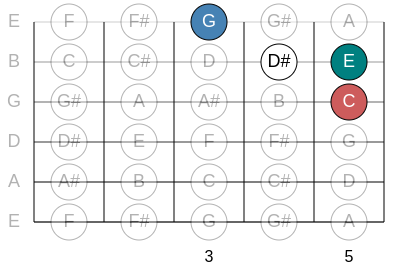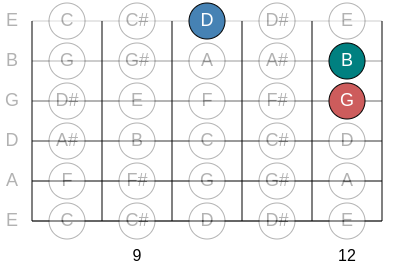To begin, what is a triad?
A set of three notes stacked vertically in thirds (interval)
From a chosen pitch, let's say C, we have E and then G. We call C the root, E the third and G the fifth, or in solfège-speak, we have C as Do, E as Mi and G as So.
Major triads
I'm starting to practice with both major and minor triads on the guitar, starting with the 1st three strings (G-B-E). If we take the key of C, and pick a progression, such as I-IV-V, then the triads are:
- I: C-E-G
- IV: F-A-C
- V: G-B-D
We can then play them in the root position (root is the lowest note) as follows,



which is simply a matter of sliding up and down the neck once you have the fingers down in that position. Now we can introduce the other two inversions of the same triad,
- 1st inversion: third of triad is lowest note
- 2nd inversion: fifth of triad is lowest note
So the first inversion, 3-5-1 or Mi So Do,
- I: E-G-C
- IV: A-C-F
- V: B-D-G



And finally, the second inversion, 5-1-3 or So Do Mi,
- I: G-C-E
- IV: C-F-A
- V: D-G-B



It's good to memorise these shapes, and remember that the root of the triad is on the lowest string G in the root position, the first string E in the first inversion, and the second string B in the second inversion.
Minor triads
If we flat the third by a half-step, we get the minor triads. Using the same example as before,
- I: C-Eb-G
- IV: F-Ab-C
- V: G-Bb-D
The updated shapes for the C minor triad,
Root position

1st inversion

2nd inversion

Connecting the "dots"
If we take the progression of I-IV-V as before, we can connect the notes of the triads using the shapes above. For example,

An exercise over a 4/4 measure, playing quarter notes, might look like,
- Using the C major triad in root position, play notes C-E-G-E
- Using the F major triad in 2nd inversion, play notes C-F-A-C
- Using the G major triad in 1st inversion, play notes B-D-G-D
- Repeat
while staying within the 3rd positions (frets 3 to 6).